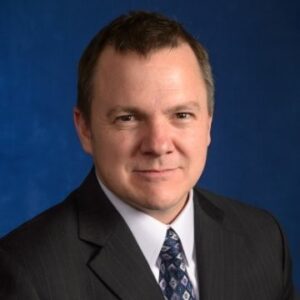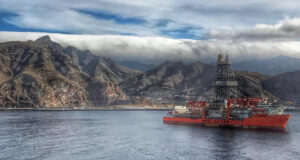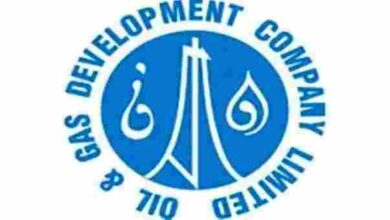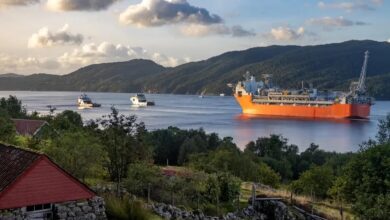Investments in digital systems, sustainability will help drillers carve niche in new landscape


Seadrill’s Simon Johnson: Drilling contractors may also need further collaboration with operators to integrate wellsite data, review how risk is allocated in today’s rig contracts
By Stephen Whitfield, Associate Editor
Simon Johnson is President and CEO of Seadrill.
How would you assess the state of the global offshore drilling market right now?
I don’t think it’s that different from previous cycles. We’re facing the same issues that we have in past upticks. We’re dealing with cost inflation. It’s getting hard to find personnel. We’re struggling – and our vendors are struggling – with essential equipment deliveries and lead times. Projects are overrunning in cost and time, and our customers are becoming anxious about the impact of that on their work programs. So, it’s familiar muscle memory being reactivated.
The difference is that this is coming after the most protracted downturn in our business. A lot of people have left the industry. A lot of organizational knowledge and memory is gone. We’re having to re-learn some old ways while dealing with new challenges.
How is inflation impacting your business?
It makes it difficult to forecast for your business because you don’t know how that inflation is going to impact projects that you’re planning two or three years out. The vendors themselves are typically just one layer in a very complicated service delivery value chain. It’s layer upon layer upon layer, so the days of dealing with a vendor that has complete control of its business is gone. One piece of equipment might be assembled with different components from all over the world.
Can you give an example?
An example would be with the dispute in Ukraine. One of the things that many people aren’t aware of is that Russia and Ukraine both produce crucial materials for the manufacture of semiconductor chips, such as inert gases. They are a vital component in everything from TVs to PCs to the equipment we use on our rigs. This kind of interdependence makes it much more complicated to have a complete understanding of your supply chain and how everything comes together.
Staying on the topic of Ukraine, the theme of energy security has become huge, and Europe is in the midst of a burgeoning energy crisis. Given how long it takes to get a conventional oil and gas project going, is there anything that can be done in the short term to help alleviate the supply shortfall?
I think the industry is absolutely fundamental to energy security, and there’s no new technology I’m aware of that can substitute for drilling contractors’ critical role of penetrating the reservoir and delivering hydrocarbons to surface. Until there is, we’re fundamental to the production of oil and gas.
The countries that have better managed their resources and that have good frameworks for consistent investment through time – a good example is Norway – have an opportunity to profit from their approach in the short term.
However, as you point out, it takes around six years to take a drop of oil from discovery to production, depending on infrastructure and other issues. It’s a long development cycle. Now, all of a sudden, a lot of people are worried that they’re not going to have gas to heat their homes this winter.
The problems that have caused that situation have their root in a failure to give the oil and gas industry a stable investment environment over the past eight years. In my opinion, drilling contractors, oil and gas companies, and service companies have all been decried and actively persecuted. The policymakers and politicians didn’t understand that we need a multiplicity of energy sources.
It’s not like substituting one for the other. While renewable sources are an important part of future energy needs, they don’t provide that baseload response. They don’t provide the same utility in terms of dispatchable energy.
Now we have a problem, but it can’t be turned around through a single policy change. It will take years. I think the short-termism of political processes in countries all over the world – the three- to four-year cycles – doesn’t encourage policy setters to think longer term.
We can’t engage with the future without understanding that there’s no bridge between that future and how the world works today.
The last downturn brought about an increased focus on capital discipline. As the market recovers, do you think we’ll see a shift back to more of a focus on investing in rig newbuilds or upgrades?
No, I think capital discipline still is the No. 1 concern of management teams. The Chapter 11 process, which most drillers have been through, is still a very recent memory, and there’s a lot of scar tissue around that. The directors of the newly constituted boards, the stakeholders and the investing public – all of them are concerned that drilling contractors can’t be trusted when the terms of trade change in their favor. They think we’ll lose sight of that cost discipline and start throwing money at new investments.
I don’t think that’s going to happen this time, though, because this downturn has been so protracted and there have been so many painful lessons learned.
Also, there’s an understanding that management doesn’t necessarily control these companies in the same way as they did in the past. I think one of the biggest problems in the industry had been a principal/agent problem between management and the shareholders. Even though being a drilling contractor is an incredibly capital-intensive business, the management teams had been left for many years to preside over their businesses with very little direct input from the shareholder base. That’s now changed. There is far more scrutiny on management, and I think that will continue to put capital discipline at the forefront.
If we’re not going to see investment being directed to newbuilds, then where will capital go and how do you make sure that your rigs stand out among the competition?
Even in an environment of discipline, our business still requires a lot of capital.
You’re starting to see some technologies and equipment that were previously the domain of the service companies becoming part of the rig equipment set, and that requires a lot of capital. MPD, for example, is becoming far more common, particularly in areas like the deepwater Gulf of Mexico and South America. The average MPD setup will run to about $30 million – and that’s excluding the OPEX component.
We’re also doing things around digital to gain a competitive advantage. Even through the downturn we’ve been working continuously to develop ways to make better use of our data – for example, to optimize service intervals and maintenance activities. Your readers may have seen some of the thought leaders from our Technical Services team sharing our ideas around asset lifecycle management at IADC conferences. We’ve been investing in that because we think it’s going to have an enduring value in terms of our total cost of service delivery.
Of course, we’ve also been investing in sustainability, although that’s not so much of a competitive response than it is a stakeholder response. We’re doing that with the understanding that we need to be a good corporate citizen, and we need to respond to the community’s expectations about us minimizing our carbon footprint.
There’s also a prospect that this can be a business that generates large dividends to its investors – and if not dividends, then we can consider share buybacks. Basically, anything that returns capital to shareholders that is not utilized by the enterprise.

When you talk about investments in sustainability, are you talking about things like selective catalytic reduction (SCR) systems and battery energy storage systems?
Yes. We’ve done a lot of work around battery technologies and deployed one of the first battery systems on the West Mira semisubmersible in the Norwegian North Sea. And on the West Saturn, which just commenced work with Equinor in Brazil, we’ve installed a range of new technologies designed to reduce the rig’s carbon footprint, like closing the bus ties on the power distribution and trialing some novel fuel additives.
It seems like reducing power usage on the rig is where a drilling contractor is going to see the biggest bang for the buck in terms of emissions reduction.
Everything on our rig is powered by the diesel we combust. So, fuel consumption is the most measurable, impactful improvement that we can make in our activities. But the interesting thing about it is that a lot of people are focusing on fuel injection technology, engine management technology and emissions controls like SCRs. However, we’re finding that the biggest bang for our buck in terms of improving outcomes is simply to engage the people on the rig in tweaking settings on things like transfer pumps to reduce the energy demand to run the rig. We’re finding smarter ways to distribute the energy on the rig and consume less of it in day-to-day operations.
It’s interesting that, in just the last few years, sustainability has shifted from being something that’s nice to have in your portfolio to something you must have in your portfolio.
That’s true. We’ve been self-reporting to the Carbon Disclosure Project, a global disclosure group, on our emissions footprint for the better part of 10 years now. The first thing you need to do on the environmental side is measure your emissions and start tying your activities to a measurable improvement in what you’re doing.
But what’s more interesting about the ESG conversation is the governance and community aspects. They might not be as sexy to talk about, but we’ve been doing a tremendous amount of work in terms of our interaction with local communities in the countries where we work.
On the governance side, we’re continually advancing our practice in the area of corporate compliance to ensure that we do business in a transparent and accountable manner. It’s all part of the triple bottom line. We get as many questions about the social and environmental aspects of our organization as we do about downtime and revenue performance.
What would you say to a young person looking at this industry for a potential career?
What I would say to them is that we’re in a period of energy “addition,” not “transition.” Yes, the business has shrunk, but if we’ve learned anything from what’s happening in Europe right now, it’s that a diversity of energy sources is absolutely critical to a country’s security.
We must get the young talent re-engaged. They see us as more of a brownfield tail-end industry rather than something that’s going to be an enduring source of employment and professional development into the future, and that simply isn’t the case.
We should also tell them how we’re applying leading-edge technologies. Some of the technology that we’ve developed on the maintenance side with condition-based monitoring is being used in Formula One today.
We’re also looking to bring in new types of workers. The industry used to be cast as a heroic scene of a roughneck in torn and dirty clothing. The reality is that our business is increasingly about equipment that will be remotely operated. The people who are going to be most important are not necessarily the equipment operators but rather the system commanders, like data scientists. We’re mining their knowledge to improve the systems that run our business. Going forward, it’s going to be less about big muscles and more about big minds.
What do you think will be the next step change in reducing major accident risk on the rig?
I think it will be a progression of phases. The first step is to get the drilling team off the rig floor so they will be close to, but remote from, the equipment. The next step is to get them off the rig and operating the equipment from shore. The big problem with that, up until now, has been latency, the rate at which we can pass signals backwards and forwards. There’s been a big step in that with Starlink (satellite internet system). In the Gulf of Mexico, we can now get 10 to 50 times faster data transfer speeds compared with conventional rig satellite communications.
We have more work to do to fully utilize that medium, but the speed of data transfer is approaching a level where it makes sense to operate things from shore. I believe there will be a progressive move in that direction over time.
When you get latency shrunk down, you start approaching truly real-time data. Is that going to be a game changer for remote operations?
That’s right, but I think the most important thing is not so much the remote operation bit. It’s more about making sure that the person who’s in charge of the equipment can be more of a systems commander than an equipment operator, that the equipment is thinking for itself. We’ll be using machine learning and algorithms to make the equipment work in a sophisticated manner that is not hampered by the human’s imperfect execution ability.
Do you see that automation, in its current state today, is bringing concrete, quantifiable value to drilling operations?
You’re definitely seeing it now. Automatic tripping is becoming a relatively common thing. We have that on the West Saturn today, for instance. It’s progressively making its way through the system of work. We don’t have a fully automated system, but we have sequences of work where we can automate them and have confidence in their ability to be robust through time and deliver results better than a human-managed process can.
However, drilling a well is a complex series of interrelated steps, so what people have been focusing on is doing those repetitive steps where the removal of human variability is most valuable.
We’re also seeing that sensors have plummeted in cost and skyrocketed in quality, so today’s rigs are much more sensate than they were even five years ago. And as the cost of these sensors gets lower and the amount of information we can gather with them becomes richer, the possibilities open up for not only automating sequences of work but also automating safety processes, things like automated BOP control. Instead of waiting for someone to go to the BOP panel and close an annular or the pipe rams, we can have a system powered by sensors to make a decision.
In what aspects of drilling projects have you seen more collaboration between drilling contractors and operators? Going forward, what are some things that either party can do to advance collaboration?
I think the data environment is important. Historically, there’s been a separation between the data that’s gathered about the control of the equipment at surface and the data that’s acquired subsurface.
There have been a lot of issues about confidentiality, but to optimize what’s happening downhole, you need the information that’s gathered from the equipment that rotates the drill string. We can optimize our rate of penetration against the objectives of the operator if we have more data about what’s happening downhole. I think a commonality in terms of that data pool has some great benefits for all parties, not just operators and drilling contractors but also service companies.
There are some great lessons that offshore can learn from the Lower 48 onshore, in terms of how the drilling contractor has acted as the wellsite integrator to bring everything together into one data pool and reduce the number of service interfaces.
I think we also need to revisit the contractual bargain. There’s a lot of work to be done around business models with regards to alignment of purpose and allocation of risk. The model that’s currently in use today is a bit shabby, frankly, and is worthy of some reconsideration and re-contemplation. That will need to be approached from both sides.
You mentioned allocation of risk. How has that changed in contracts in recent years, and what work do you think needs to be done to make that fit with the current drilling environment?
The typical allocation of risk has been that the reservoir pollution from the well was the operator’s concern, and pollution from the rig, as well as the safety incidents and control of our equipment, was our problem. The problem is that, over the years, those interfaces have been challenged and moved around due to changes in the insurance market.
Today, the operators have very little insurance to cover their own wellsite risks. Instead, what they seek to do is take the risk that they accept in a drilling contract and put that on their balance sheet. In doing so, they now have an interest in redrawing the traditional contractual bargain to their advantage through time by imposing carve-outs and weakening indemnities generally.
Through downturns, the offshore drilling contractors have been forced – as a commercial necessity – to accept worse and worse terms. Now, we have levels of responsibility and exposure that are unmatched by the commercial reward that’s on offer. You have company-killing risks – around things like blowouts, pollution events and the conduct of personnel – that are completely disproportionate to the incremental revenue that we might earn once you’ve allocated all the costs of running a drilling rig.
There are a lot of uncertainties in offshore drilling, and I would argue that we’re not fully recompensed for the risks that our shareholders are underwriting.
Is the dayrate model an adequate model for this economic environment? Does the industry need to move on to something else?
It doesn’t really align the interests of operators and drilling contractors, but the problem has always been that no one wants to move on to another model. The customers want to get whatever price is in the market. They don’t want to get caught paying too much, but they also don’t necessarily want to get caught paying too little.
I think that the dayrate model has proven to be a crude but ultimately effective measure that gives the drilling contractor visibility in terms of an earnings profile, but I am not sure it drives the best outcomes at the wellsite or through time. DC




